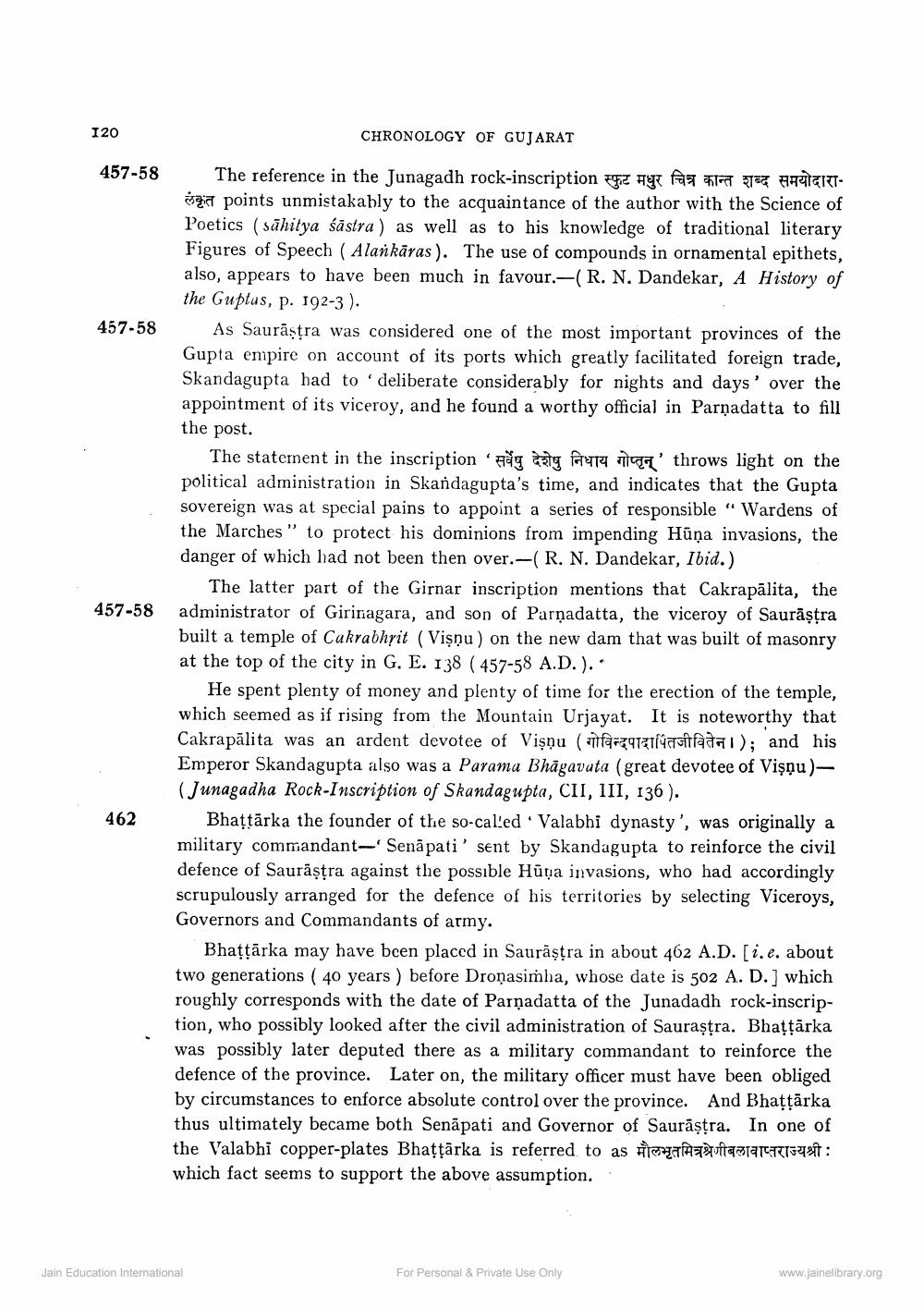________________
120
CHRONOLOGY OF GUJARAT
457-58
457-58
457-58
The reference in the Junagadh rock-inscription स्फुट मधुर चित्र कान्त शब्द समयोदाराega points unmistakably to the acquaintance of the author with the Science of Poetics (sūhitya śāstra) as well as to his knowledge of traditional literary Figures of Speech ( Alankāras). The use of compounds in ornamental epithets, also, appears to have been much in favour.-(R. N. Dandekar, A History of the Guptus, p. 192-3).
As Saurāşțra was considered one of the most important provinces of the Gupta empire on account of its ports which greatly facilitated foreign trade, Skandagupta had to deliberate considerably for nights and days' over the appointment of its viceroy, and he found a worthy official in Parņadatta to fill the post.
The statement in the inscription såg at foreta throws light on the political administration in Skandagupta's time, and indicates that the Gupta sovereign was at special pains to appoint a series of responsible " Wardens of the Marches” to protect his dominions from impending Hūņa invasions, the danger of which had not been then over.-(R. N. Dandekar, Ibid.)
The latter part of the Girnar inscription mentions that Cakrapālita, the administrator of Girinagara, and son of Parņadatta, the viceroy of Saurāştra built a temple of Cakrabhrit (Vişnu) on the new dam that was built of masonry at the top of the city in G. E. 138 ( 457-58 A.D.).
He spent plenty of money and plenty of time for the erection of the temple, which seemed as if rising from the Mountain Urjayat. It is noteworthy that Cakrapālita was an ardent devotee of Vişņu (sfarceratuqtada ; and his Emperor Skandagupta also was a Parama Bhāgavuta (great devotee of Vişņu)(Junagadha Rock-Inscription of Skandagupta, CII, III, 136 ).
Bhattärka the founder of the so-called . Valabhi dynasty', was originally a military commandant-Senā pati' sent by Skandagupta to reinforce the civil defence of Saurāṣtra against the possible Hūta invasions, who had accordingly scrupulously arranged for the defence of his territories by selecting Viceroys, Governors and Commandants of army.
Bhațțārka may have been placed in Saurāştra in about 462 A.D. [i.e. about two generations ( 40 years ) before Dronasimha, whose date is 502 A. D. ) which roughly corresponds with the date of Parņadatta of the Junadadh rock-inscription, who possibly looked after the civil administration of Saurastra. Bhattārka was possibly later deputed there as a military commandant to reinforce the defence of the province. Later on, the military officer must have been obliged by circumstances to enforce absolute control over the province. And Bhațțārka thus ultimately became both Senāpati and Governor of Saurāṣtra. In one of the Valabhi copper-plates Bhattarka is referred to as मौलभृतमित्रश्रेणीबलावाप्तराज्यश्री : which fact seems to support the above assumption.
462
Jain Education International
For Personal & Private Use Only
www.jainelibrary.org




